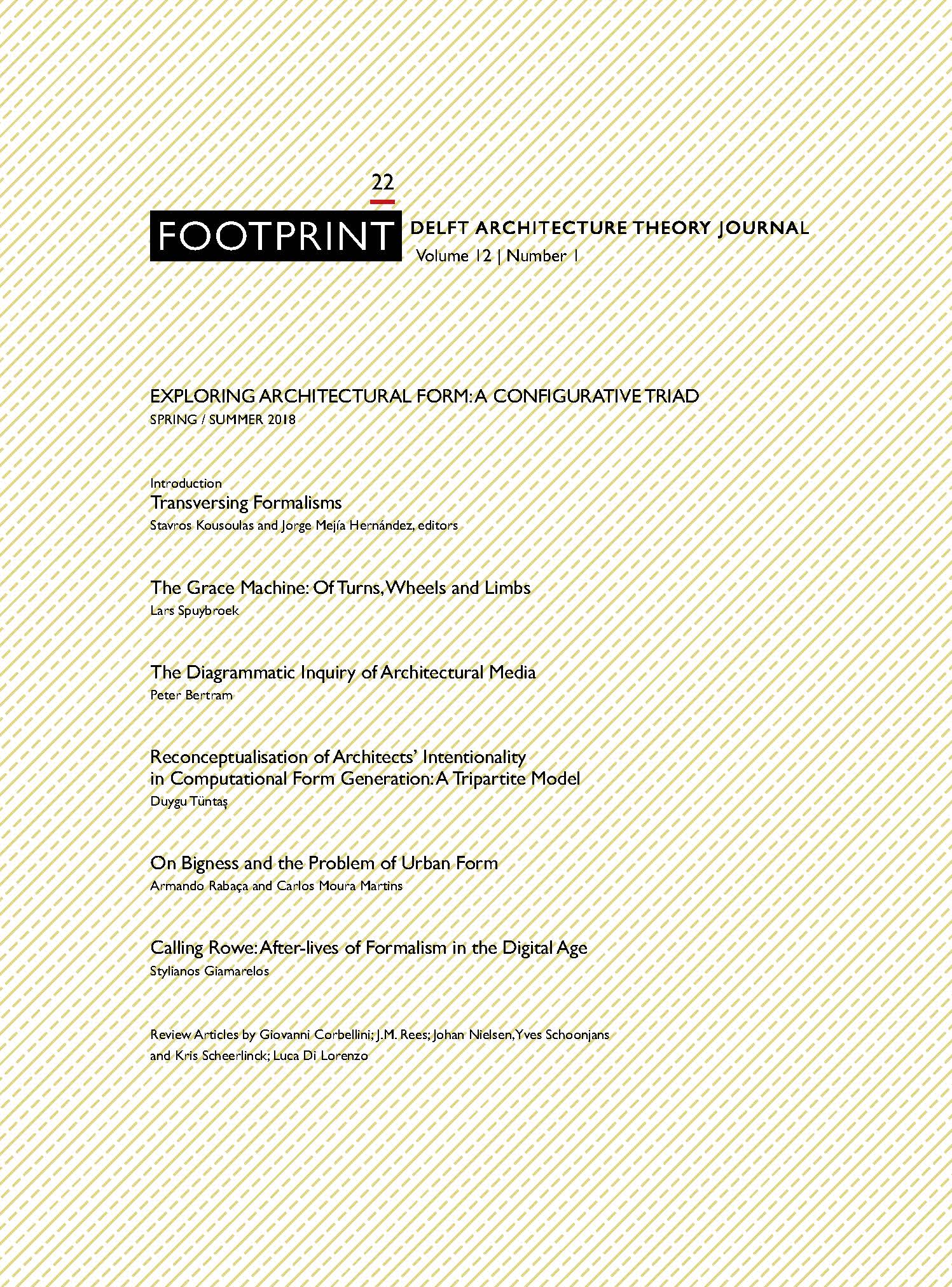Reconceptualisation of Architects’ Intentionality in Computational Form Generation: A Tripartite Model
DOI:
https://doi.org/10.7480/footprint.12.1.1756Abstract
This paper attempts to create a theoretical framework to reconceptualise architects’ intentionality in computational form generation. Parallel to the increasing complexity of design problems and the increased realm of architects’ responsibility, the last two decades have shown that a vast amount of information can be managed and operated within the design process by using computational methods and associated technologies. This condition led to an expansion of the dominant mode in form computation that largely relies on data-driven forms as outcomes of pure calculations and rationalistic determinism. As an alternative, this study proposes a tripartite model as a basis to understand and assess design intentionality by unfolding and thereby reflecting on designers’ internalised processes. Initially defined in the field of computation, network and communication sciences for management and organisation of information, the proposed model – composed of centralised, partial and distributed approaches – is operational in responding to different forms and degrees of design intentionality within computational processes in architecture.
References
Anstey, Tim et al. Architecture and Authorship (Black Dog Publishing, 2007)
Ayata, Kutan. “Ruptured Flows: An Argument for Nonlinear Workflows,” (AD, 2017), 90-95.
Barabasi, Albert-Laszlo. Linked: The New Science of Networks (2002)
Baran, Paul. “On Distributed Communications,” RAND (1964)
Benjamin, David. “Beyond Efficiency,” Birkhäuser Generalstandingorder : Digital Workflows in Architecture : Design – Assembly – Industry (Basel, CHE: Birkhäuser, 2012), 14-25.
Burry, Mark. Scripting Cultures: Architectural Design and Programming (Wiley, 2011)
Carpo, Mario. “Tempest in a Teapot,” Log 6 (2005), 99-106.
Doscher, Marty. “Disposable Code: Persistent Design,” Birkhäuser Generalstandingorder : Digital Workflows in Architecture : Design – Assembly – Industry, ed. Scott Marble (Basel, CHE: Birkhäuser, 2012), 207.
Eilam, Eldad. Reversing: secrets of reverse engineering (John Wiley & Sons, 2005)
Fischer, Thomas. “Geometry Rationalization for Non-Standard Architecture,” Architecture Science (No. 5, June 2012), 25-46.
Futamura, Yoshihiko et al. “Essence of generalized partial computation,” Theoretical Computer Science (Volume 90, Issue 1, 1991), 61-79. Accessed 10/06/2016,
<http://www.sciencedirect.com/science/article/pii/030439759190299H>
Garber, Richard. “Digital Workflows and the Expanded Territory of the Architect,” (AD, 2017), 6-13.
Institute of Network Cultures. Accessed 10/06/2016, <http://networkcultures.org/unlikeus/resources/articles/what-is-a-federated-network/>
Kilian, Axel. “Computational Design as a Process to Support Design Exploration rather than Design Confirmation,” in Dosya 29: Computational Design (November 2012), 43-46.
Leach, Neil. “Digital Morphogenesis,” AD (Volume 79-1, 2009), 32-37.
Lorenzo-Eiroa, Pablo. “Form in Form: On the Relationship between Digital Signifiers and Formal Autonomy,” Architecture in Formation: On the Nature of Information in Digital Architecture, ed. Pablo Lorenzo-Eiroa and Aaron Sprecher (Routledge, 2013), 12-23.
Marble, Scott. “Editor’s Notes: Authorship,” Birkhäuser Generalstandingorder: Digital Workflows in Architecture : Design – Assembly – Industry (Basel, CHE: Birkhäuser, 2012), 26. Accessed 23 February 2016. ProQuest ebrary. <http://www.ebrary.com.ezproxy.cul.columbia.edu>
Marble, Scott. “Introduction, From Process to Workflow: Designing Design, Designing Assembly, Designing Industry,” Birkhäuser Generalstandingorder : Digital Workflows in Architecture : Design – Assembly – Industry (Basel, CHE: Birkhäuser, 2012), 7-11.
Maturana, Humberto, and Daniel Rosenberg. “Design as Doing: A Conversation with Humberto Maturana about What Designers Do,” in Dosya 29: Computational Design (November 2012), 19-23.
Mayne, Thom. “Shift 2D to 3D,” Birkhäuser Generalstandingorder: Digital Workflows in Architecture : Design – Assembly – Industry. (Basel, CHE: Birkhäuser, 2012), 202-203.
Mennan, Zeynep. “Mind the Gap: Reconciling Formalism and Intuitionism in Computational Design Research,” Footprint: Dynamics of Data-Driven Design (Delft Architecture, Autumn 2014), 33-42.
Michalatos, Panagiotis. “Design Signals: The Role of Software Architecture and Paradigms in Design Thinking and Practice,” AD (5/2016), 109-115.
Mitchell, William et al. “Top-Down Knowledge-Based Design,” CAAD Futures Digital Proceedings (1989),137-148.
Mitchell, William. “Foreword,” in Expressive Form: A Conceptual Approach to Computational Design (Spon Press, 2003)
Olsson, Mats-Olov. “Schools of System Thinking – Development Trends in System Thinking,” in Systems Approaches and their Application: Examples from Sweeden, (Eds) Mats-Olov Olsson, Gunnar Sjöstedt (2004), 31-74.
Schumacher, Patrik. Autopoiesis of Architecture: A New Agenda for Architecture, Vol.1 (Wiley, 2011)
Snooks, Roland. “Volatile Formation,” Log 25 (Summer 2012)
Stiny, George. “What designers do that computers should,” in The Electronic Design Studio: Architectural
Education in the Computer Era, ed. Malcolm McCullough et al. (MIT Press, 1990),17-30.
Terzidis, Kostas. Expressive Form: A Conceptual Approach to Computational Design (Spon Press, 2003)
Wiscombe, Tom. “Emergent Models of Architectural Practice,” Perspecta 38 (2006), 59-68.
Wiscombe, Tom. Interview by Ralf Broekman and Olaf Winkler, Build Magazine (March 2010) Accessed 07/09/2017, <http://files.cargocollective.com/598962/Build_Text_Dec_2011_NLH.pdf>
Zaera-Polo, Alejandro. The Sniper’s Log: Architectural Chronicles of Generation X (Actar, 2012)
Downloads
Published
Issue
Section
License
- Authors retain copyright and grant the journal right of first publication with the work simultaneously licensed under a Creative Commons Attribution License that allows others to share the work with an acknowledgement of the work's authorship and initial publication in this journal.
- Authors are able to enter into separate, additional contractual arrangements for the non-exclusive distribution of the journal's published version of the work (e.g., post it to an institutional repository or publish it in a book), with an acknowledgement of its initial publication in this journal.





